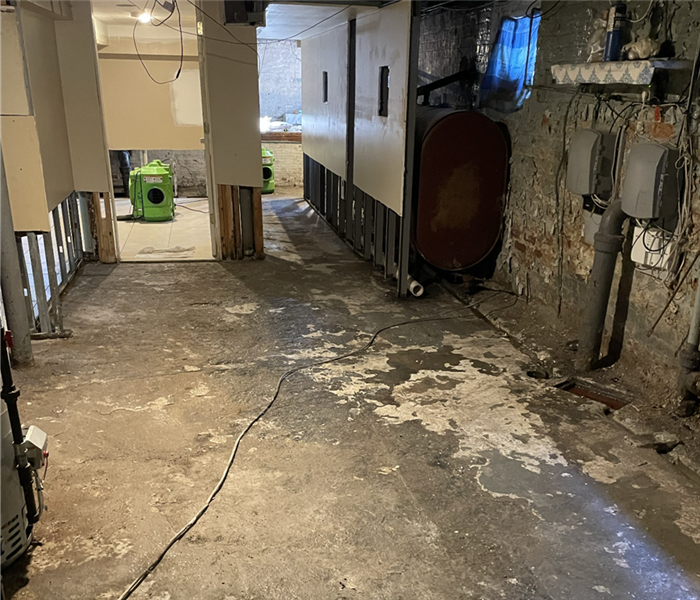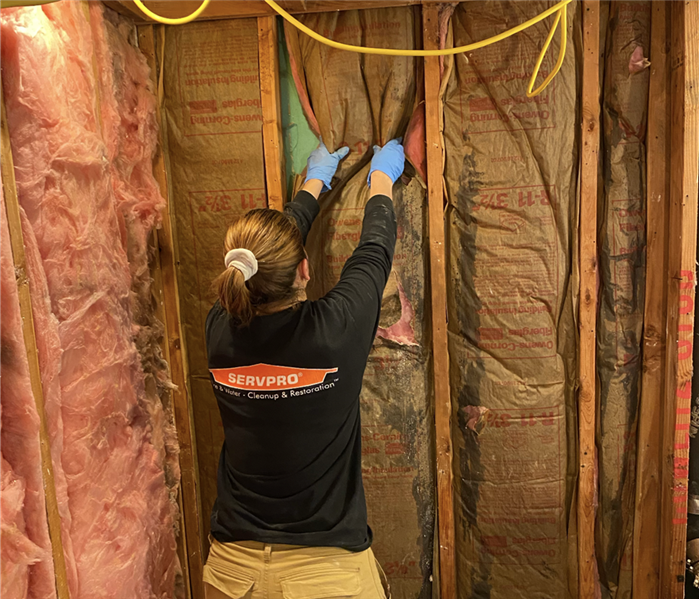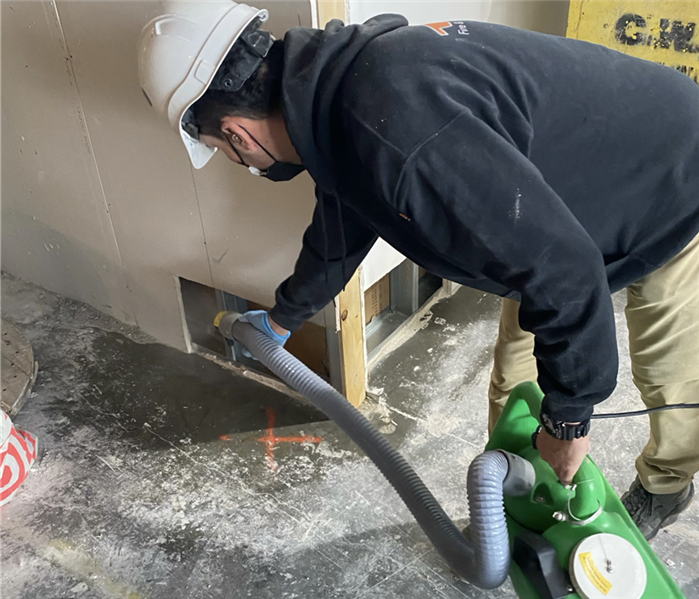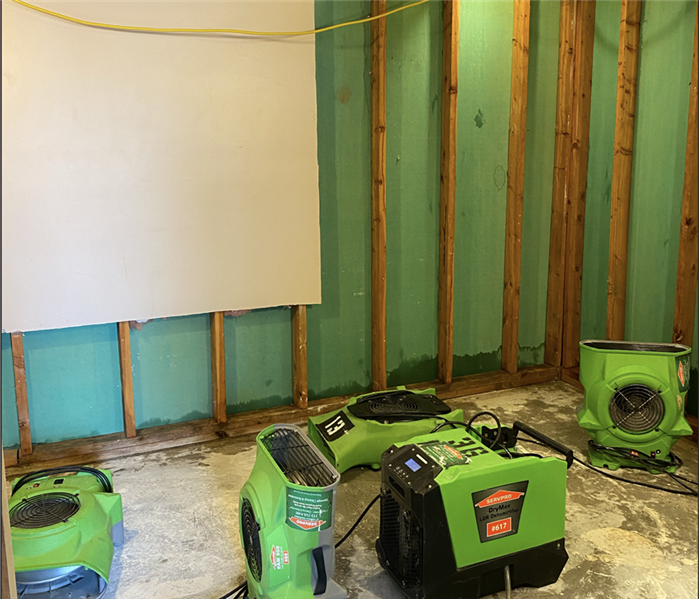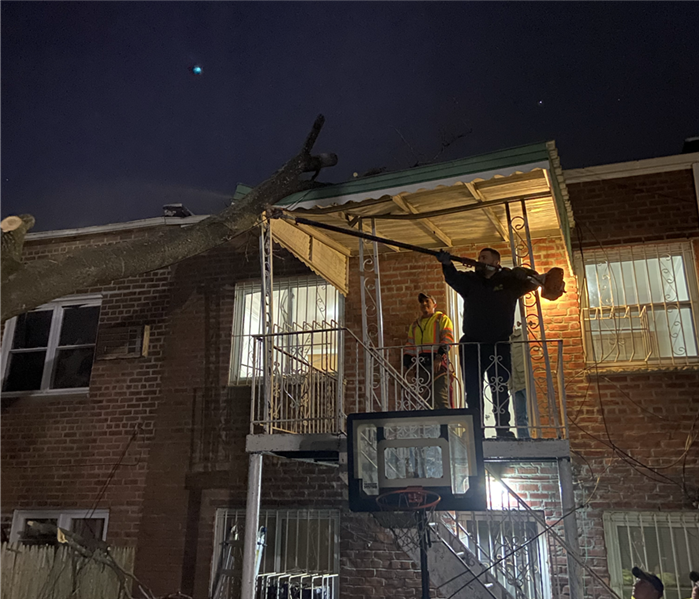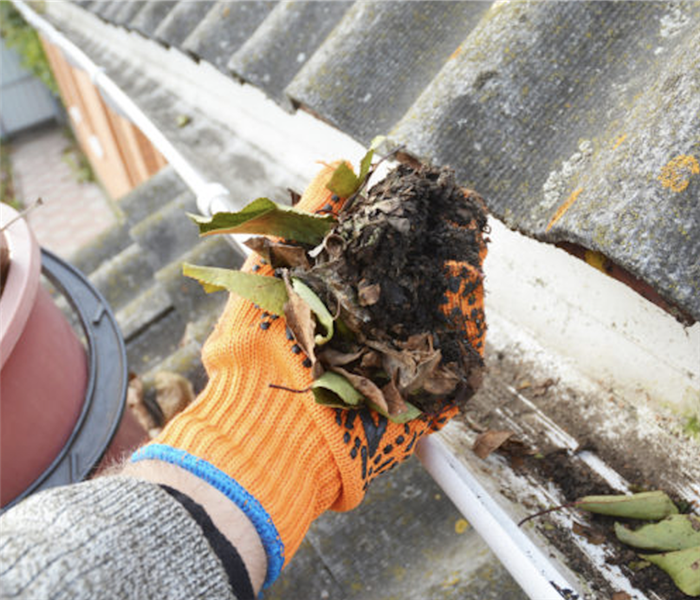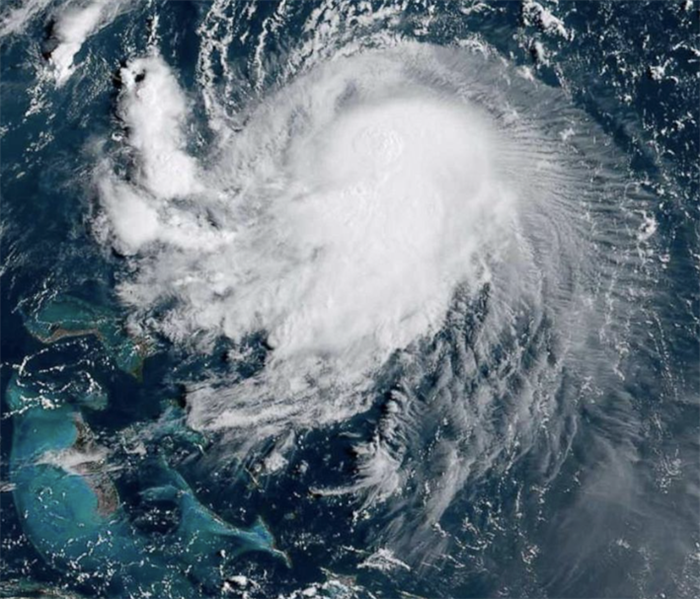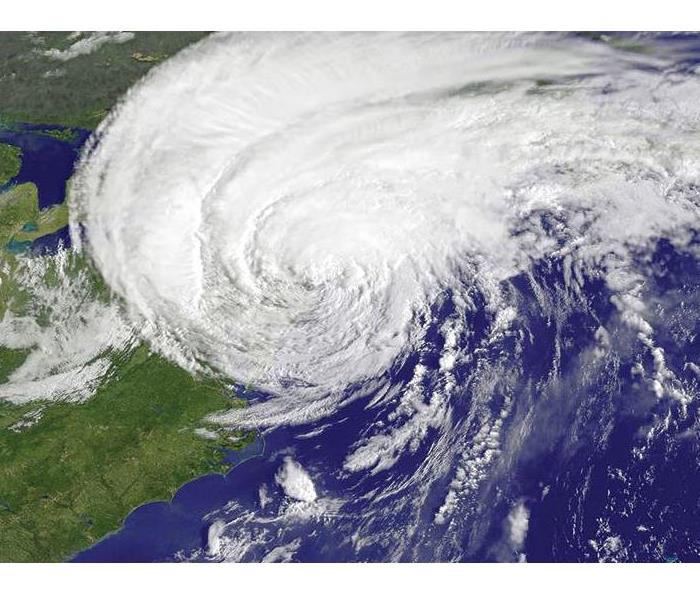Archived Storm Damage Blog Posts
Surviving the Storm: Essential Tips for Storm Preparedness & Recovery
8/14/2023 (Permalink)
Storms are a force of nature that can cause substantial damage to homes and businesses. Understanding the risks, preparing effectively, and knowing how to respond in the aftermath are critical steps to safeguarding your property and ensuring a swift recovery. Here are some important guidelines on how to be storm-ready and recover efficiently.
Understanding the Risks
Every storm carries its unique set of risks. Torrential rains can lead to flash floods, high-speed winds can cause structural damage, and lightning can spark fires. Identifying the specific threats associated with different types of storms in your region can inform your preparedness strategies and response mechanisms.
Storm Preparedness
1. Safeguard Your Property:
Your property is your first line of defense against a storm. Regularly inspect your home or business premises for potential vulnerabilities. Ensure your roofing is in good condition and that gutters are clean and damage-free. Secure loose items outside your property that could become dangerous projectiles in high winds. Install storm shutters or use plywood to protect windows.
2. Create a Disaster Plan:
Develop an emergency plan that includes evacuation routes, meeting points in case family members or employees get separated, and a list of emergency contacts. Consider the needs of pets and any special requirements of family members or employees.
3. Assemble an Emergency Kit:
Keep a kit ready with essential items like bottled water, non-perishable food, flashlights, extra batteries, first-aid kit, necessary medications, important documents, and a battery-powered or hand-cranked radio.
Weathering the Storm
1. Stay Informed:
Follow the latest weather forecasts and heed local authorities' advice. If ordered to evacuate, do so promptly. Your safety should always be the priority.
2. Secure Your Property:
Before the storm hits, ensure your property is as secure as possible. Bring outdoor furniture inside, shut off utilities if instructed to do so, and lock all doors and windows.
After the Storm
1. Assess the Damage:
Once it's safe to return, assess your property for damage. Document the damage for insurance purposes by taking pictures and making detailed notes.
2. Cleanup and Restoration:
Post-storm cleanup and restoration can be a complex process, often requiring professional assistance. SERVPRO's expert teams are trained to handle post-storm cleanup and restoration, helping you get your property back to its pre-storm condition as quickly and efficiently as possible.
Storms can be formidable, but with preparation and the right recovery partner, you can weather them and bounce back effectively. Remember, when the storm passes, SERVPRO is ready to assist with cleanup and restoration services. To learn more, reach out to us anytime at 212-768-9400. Your safety and quick recovery are our top priority.
Flooding After the Storm... What Next?
8/31/2022 (Permalink)
What to do-
The second you notice flooding in your home do not hesitate to call SERVPRO immediately! Time is the biggest factor in preventing further damage, as well as slowing the spread of water into places like your floors and walls. With a quick enough reaction to the issue we can make a huge difference. Regardless, if you notice damage days after a storm we can still help. With a team of experts who know the ins and outs of storm damage we can find the source and solution to your issue. Not only do we perform the cleanup and treatment of the area, we restore what was ruined. When we leave it will be, "Like it never even happened".
Spring Brings Thunder and Lightning, How to Prepare
4/30/2022 (Permalink)
Thunderstorms Have the Potential to be Dangerous-
Below we have listed some advice to stay safe during a thunderstorm. Make sure you follow these tips to prepare yourself and your household for a potentially dangerous storm. Thunderstorms occur often and can cause a lot of damage to your home you don’t want to deal with. Of course, there are ways to help prevent or minimize any damage, to prepare for a Thunderstorm, you should do the following:
Create a Plan and a Store Supplies-
- Remove dead or rotting trees and branches that could fall and cause injury or home damage.
- Secure outdoor objects that could blow away or cause damage to your home.
- Stay inside your home or a secure building until the storm has passed.
- Shutter windows and secure outside doors. If shutters are not available, close window blinds, shades/curtains.
Some Thunderstorm Facts You May Not Have Known:
-Thunderstorms can occur in clusters or in a line formation.
-A single thunderstorm can be severe if the storm stays in place, pummeling a location for a prolonged period of time.
-Warm, humid conditions are highly favorable for the development of Thunderstorms.
-Dealing with Storm Damage can be made easy, call our team at SERVPRO of Midtown Manhattan for help at 212-768-9400!
What to Avoid After a Flood
4/23/2022 (Permalink)
Keeping Yourself Safe During a Flood
In the midst of a storm, water can invade your home and cause considerable damage to your property in the form of flooding. However, your main priority should always be to keep yourself, your family members, and your pets to safety. Let the storm pass and when conditions are safe, you can return to assess the damage, and then begin the cleanup process. Below are some things you should not do when returning to the site of a flood:
Do Not Make Contact With the Water-
Floodwater can contain many different types of contaminants including bacteria, viruses, chemicals, and debris. Help protect your skin from harmful water by wearing rubber boots and gloves and keeping your hands and face from making contact with the water. If contact occurs despite your best efforts, wash immediately with soap and clean water.
Do Not Enter Standing Water-
After a flood, homes, yards, streets, and other areas can be covered in standing water. Powerful winds often accompany heavy storms, so it is not uncommon to find downed powerlines after a storm. Since water from a flood is usually murky, you cannot always tell what lies beneath the surface. If the water has been electrically charged, you could experience an electric shock if you enter a flooded home. Rubber boots will help protect against the risk of electrocution.
Do Not Let the Water Sit
The longer water sits, the more time bacteria have to multiply. When items are left to sit in water for long periods of time, the structural integrity of those items can begin to break down. The water should be safely extracted as soon as possible. By cleaning the water faster, you can help to lessen any water damage to your home. Since mold can begin forming in as little as 24 to 48 hours, it is important to begin the drying process as soon as the water has been extracted.
By following a few precautions, you can help keep yourself safe from the dangers of floodwater.
If you ever experience a flood or some type of water damage in Midtown Manhattan, a professional restoration company like SERVPRO can help get your home back to its original condition- or better. Call us 24/7 at 212-768-9400 for a free assessment and quick help!
Why Standing Water Should Be Avoided
4/23/2022 (Permalink)
Flood Water, Be Careful!
After flooding occurs, the surface water left behind can affect your Midtown Manhattan home and or office. Standing water can absorb into the materials and ultimately allows for the deterioration of exposed structural elements. The pooling of the water can also present potential health effects or hazards for those exposed and remaining in the area. SERVPRO of Midtown Manhattan offers the quickest possible extraction, as well as drying solutions for your Midtown Manhattan property after flooding. We also have ways to reduce the standing water concerns by offering extremely efficient flood removal for Manhattan homes. To accomplish this, we call upon a wide array of extraction and moisture removal tools in our well stocked inventory.
So, What Tools Are Best for Drying Up Flood Damage?
Every flooding situation is different from the last, there are different tools and machines that can remove water or dry the area better than others. Identifying the most efficient solution is always the priority, once the sooner standing water gets addressed, the less damaging the flood becomes. Some of the standard water removal and drying tools include:
- Air Movers
- Floor Mat Systems
- Dehumidifiers
- Positive Pressure Systems
- And much more!
After a flood, you want your home to look like it did before the disaster as soon as possible. Our SERVPRO of Midtown Manhattan team can help anytime you need us. Let us take the hassle of dealing with a disaster off your shoulders, call us today at (212) 768-9400
Storm Safety in Your NYC Apartment
4/21/2022 (Permalink)
Be Ready-
People of New York, the only wrong time to prepare for a hurricane or bad storm is when it’s too late! If you live near the coast, hurricanes are an ever-present danger. Knowing how and what to prepare for a hurricane can save your life and the place you call home. In the Atlantic, hurricane season lasts from June 1st to November 30th. Stay prepared with our best tips and practices for Storm Safety here in the big apple.
Prepare Online-
Doing your research and preparing for a storm by compiling a list of organizations and websites with critical information can assist you in the long run, even if it doesn’t seem necessary now.
- Bookmark the page(s) on your power company’s website where outage maps and updates are posted if the power goes out. Sign up for the company’s emergency email alerts (if they offer them) to stay in the know.
- Install FEMA’s app. If your power company has an app, install that, too.
- Photograph your items. In the event of catastrophic damage following an evacuation, photographs make filing an insurance claim easier. Store the photos online using a service such as Dropbox or Google Docs.
- Review your renters insurance policy for natural disaster protection. Then, scan your policy documents and store the file online with your photos.
- Research the most convenient evacuation centers in your area and the traffic routes you’d take to reach them. If your apartment is in an evacuation zone and you receive an evacuation order, it is in your best interest to follow it rather than waiting the storm out.
Preparing Your Apartment before a Storm
While storms can cause severe structural damage, you can take steps to keep the rain and wind at bay and keep yourself safe.
- Store everything you need to be comfortable for a few days. Create an emergency prep bag. Make sure it includes:
- A first aid kit
- Flashlights
- Batteries
- Bottled water
- Non-perishable, canned food
- Prescribed medications
- Emergency blankets
- A radio for news and weather updates
- A water purifier
- Make pet preparations. If you have a dog, cat, or other beloved pet, make sure you have an emergency prep bag for them, too! Also, locate nearby shelters or hotels that can accommodate both of you.
- Charge your devices. This includes cell phones, laptops, tablets, and, more.
- Request preventative maintenance from your landlord or super. If you have a leaky window or other outstanding maintenance issue, request that your landlord fix them ASAP before things get worse.
- Unplug electronic devices (like desktop computers) and appliances (like coffee makers and toaster ovens) if you lose power. Doing so will help prevent an electrical surge from damaging them when power returns.
If you have experienced any kind of storm damage in your Manhattan apartment be sure to give SERVPRO of Midtown Manhattan a call, let us handle the hassle of cleanup and restoration so you don’t have to.
Prepping for the Storm Ahead
4/10/2022 (Permalink)
With Winter gone and Spring weather here again, the storms can be as unexpected as the damage they cause. However, with the right preparation, most of the storm damage can be minimized or prevented entirely, saving you time and money. Below we have listed some tips to help prevent damages upcoming storms may cause.
Clean Out Your Gutters-
When it rains, and your gutters are clogged, it could cause the overflow to run down into your home. Often, this water can go undetected and sit. Over time, mold can grow in these areas that remain wet. Having clean and sturdy gutters before the rain comes can minimize the damage a storm may cause.
Maintain Landscaping and Unclog Drainage-
Depending on the land your home is built, water runoff can accumulate around your foundation, and flood your homes. Fortunately, there are solutions with the right landscaping. Better pathways can be created for water runoff, guiding the water away from your home. If you have noticed puddles or water accumulation near your home when it rains, contact a professional to help, before a storm comes. That can make the difference in whether your home is damaged or not.
Trim or Remove Damaged or Dead Trees-
Storm damage often occurs when a tree or limbs break off and fall onto a home. Snow and rain can weigh down trees, while wind can make them bend. If this happens to trees and limbs that are dead or damaged, there’s a high chance that they will break. Before the storm season comes, be sure to trim your trees, and remove all dead limbs.
Spring is Here, Time to Do a Home Checkup
4/10/2022 (Permalink)
Winter is Gone, Spring Has Arrived-
With winter behind us, New Yorkers can look forward to blooming flowers and spring cleaning now. To make sure your home is in good shape, here are some tips to inspect for damage, these will not only save you money in the long term but prevent unnecessary property damage. Even after a mild winter, it is critical to assess your property’s exterior to make sure the cold weather hasn’t left you with damages you didn’t expect. It is also important to react quickly and take the necessary steps to prevent property damage from combining with the effects of rain showers to come this spring. Winter weather can be hard on your residential and commercial property, make sure to look for problems that frigid temperatures, snow and ice may have caused.
Winter storms are accompanied by lots of moisture – snow, freezing rain, ice, hail and wind. This can cause common issues like ice dams, frozen pipes and frost heave that may cause damage to your home or business. SERVPRO of Midtown Manhattan is always there to help resolve your property damage restoration needs as soon as you call us, 24/7. Our local disaster restoration services includes:
- Inspection and Assessment of any damaged areas
- Water Removal
- Water Extraction
- Drying and Dehumidification
- Cleaning and Repairs
- Restoration and Reconstruction, as necessary.
There are several common problem areas to inspect during spring for potential damage, including your roof and gutter system, foundation and yard, plumbing system and your property’s exterior. From the top down these areas could see potential damage from the worst that the winter elements can bring. From your roof to your plumbing, here are some signs of damage to look out for:
- Roof and Gutter System Damage
- Window, Door and Exterior Damage
- Foundation and Other Drainage Problems
- Plumbing Damage
- Preventing Property Damage Starts With Routine Inspection
If you've noticed any of these above issues just give us a call at Give us a call at (212) 768-9400!
Tropical Storm Henri- What to do?
8/21/2021 (Permalink)
Tropical storm Henri is evolving into a hurricane that will slam the Northeast, high speed winds, flooding, and heavy rain are expected. It is important you and your family stay safe and prepared, below are some tips on how to do so:
How to Prepare for Tropical Storm Henri-
- Be informed- make sure you are receiving alerts, warnings, and public safety information before, during, and after emergencies.
- Learn if you live in a hurricane evacuation zone- if you do, make a plan to evacuate
- Learn whether your property is in a flood-prone or high-risk area via the Federal Emergency Management Agency’s (FEMA) flood maps.
- Create and commit to memory your family emergency plan and discuss it with them.
- Assemble an emergency kit with what you will need such as food, water, medication, and communication.
- Prepare for possible power outages and blocked streets.
- Take photos or videos of your personal property and store these records in a safe place.
- Prepare your home with temporary plywood covers to protect windows and sliding doors if possible.
Create a Plan-
- Pick more than one safe place in your home where you can go if there is an emergency.
- Pick two ways to get out in case you have to leave, and keep these exits clear.
- Pick a place for your family to meet in case you are separated -- one in and one outside your neighborhood.
- Pick a place where you can stay in case you must evacuate your home.
- Make a plan to keep your pets safe if there is an emergency.
- Know how to turn off the electricity, gas and water in your home.
- Take photos of possessions inside and outside your home in case you need them for insurance purposes.
Once it's over?
Once a hurricane is underway, the experts urge people to avoid driving and stay indoors. Flooding and damaging winds can make traveling extremely dangerous. Nearly 90% of all hurricane-related deaths involve water, according to the National Weather Service.
If you must travel, experts warn not to walk or drive through flowing water. Six inches of swiftly moving water can knock you off of your feet and cars can be swept away in just two feet of moving water. Stay safe and stay informed, SERVPRO will be there for you after the storm.
What NOT To Do After A Flood
4/22/2021 (Permalink)
During a storm, flood water can invade your home and cause considerable damage to your property. However, your main priority should always be to get yourself, your family members, and your pets to safety. Once the storm has passed, you can return to assess the damage and begin the cleanup process. Here are four things you should not do when returning to the site of a flood.
1. Make Contact With the Water
Floodwater can contain many different types of contaminants including bacteria, viruses, chemicals, and debris. Help protect your skin from harmful water by wearing rubber boots and gloves and keeping your hands and face from making contact with the water. If contact occurs despite your best efforts, wash immediately with soap and clean water.
2. Enter Standing Water
After a flood, homes, yards, streets, and other areas can be covered in standing water. Powerful winds often accompany heavy storms, so it is not uncommon to find downed powerlines after a storm. Since water from a flood is usually murky, you cannot always tell what lies beneath the surface. If the water has been electrically charged, you could experience an electric shock if you enter a flooded home. Rubber boots will help protect against the risk of electrocution.
3. Let the Water Sit
The longer water sits, the more time bacteria have to multiply. When items are left to sit in water for long periods of time, the structural integrity of those items can begin to break down. The water should be safely extracted as soon as possible. By cleaning the water faster, you can help to lessen any water damage to your home. Since mold can begin forming in as little as 24 to 48 hours, it is important to begin the drying process as soon as the water has been extracted.
By following a few precautions, you can help keep yourself safe from the dangers of floodwater.
If you have experienced a flood or any type of water damage in Midtown Manhattan, a professional flood restoration company can help get your home back to its pre-flood condition. Give our team a call at 212-768-9400 for a free assessment.
Storm Safety: Apartment Edition
4/16/2021 (Permalink)
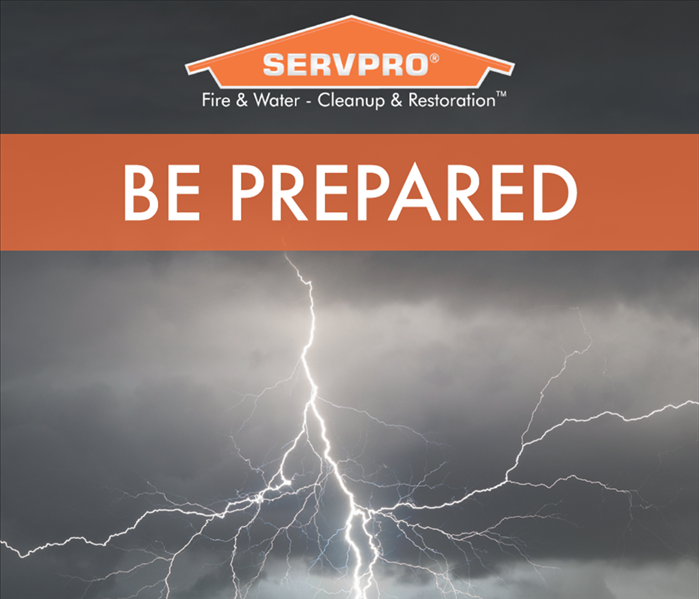 Be prepared for any storm with our apartment guide edition of Storm Safety!!
Be prepared for any storm with our apartment guide edition of Storm Safety!!
New Yorkers, the only wrong time to prepare for a hurricane is when it’s too late. If you live near the coast, hurricanes are an ever-present danger. Knowing how and what to prepare for a hurricane can save your life and your belongings.
The Atlantic hurricane season lasts from June 1st to November 30th. Stay prepared with our best tips and practices for Storm Safety here in the big apple.
Prepare Online
Do your research and prepare for a storm by compiling a list of organizations and websites with critical information that can assist you in the long run.
1. Bookmark the page(s) on your power company’s website where outage maps and updates are posted if the power goes out. Sign up for the company’s emergency email alerts (if they offer them) to stay in the know.
2. Install FEMA’s app. If your power company has an app, install that, too.
3. Photograph your items. In the event of catastrophic damage following an evacuation, photographs make filing an insurance claim easier. Store the photos online using a service such as Dropbox or Google Docs.
4. Review your renters insurance policy for natural disaster protection. Then, scan your policy documents and store the file online with your photos.
5. Research the most convenient evacuation centers in your area and the traffic routes you’d take to reach them. If your apartment is in an evacuation zone and you receive an evacuation order, it is in your best interest to follow it rather than waiting the storm out.
Prepare Inside Your Apartment
While storms can cause severe structural damage, you can take some steps to keep the rain and wind at bay.
6. Store everything you need to be comfortable for a few days. Create an emergency prep bag. Make sure it includes:
- A first aid kit
- Flashlights
- Batteries
- Bottled water
- Non-perishable, canned food
- Prescribed medications
- Emergency blankets
- A radio for news and weather updates
- A water purifier
7. Make pet preparations. If you have a dog, cat, or other beloved pet, make sure you have an emergency prep bag for them, too! Also, locate nearby shelters or hotels that can accommodate both of you.
8. Charge your devices. This includes cell phones, laptops, tablets, and, yes, even the devices you use to charge your various devices.
9. Request preventative maintenance from your landlord. If you have a leaky window or other outstanding maintenance issue, request that your landlord fix them now before things get serious.
10. Unplug electronic devices (like desktop computers) and appliances (like coffee makers and toaster ovens) if you lose power. Doing so will help prevent an electrical surge from damaging them when power returns.
Prepare Outside Your Apartment
11. Test your generator (if you have one) to ensure it’s in good working order. Also, verify that you have enough gas to operate it.
12. Report any overgrown tree branches that risk falling on your unit. Heavy tree branches can damage your belongings and your vehicle.
13. Secure any outdoor items. You’ll reduce the risk of them being scattered or damaged by high winds and heavy rain.
14. Park your vehicle in a safe location. Park your car away from possible flooding areas or places where it could be in danger of falling debris.
15. Get to know your neighbors. Working together helps everyone stay safe during a hurricane. Suggest an emergency fund to repair damage to common areas or help neighbors heavily-impacted by the storm.
At SERVPRO of Midtown Manhattan, we understand that natural disasters can be catastrophic. We're dedicated to educating and servicing our community to help keep all New Yorkers safe. If you're dealing with damage from a storm, give us a call at 212-768-9400.
Is Standing Water Dangerous?
4/16/2021 (Permalink)
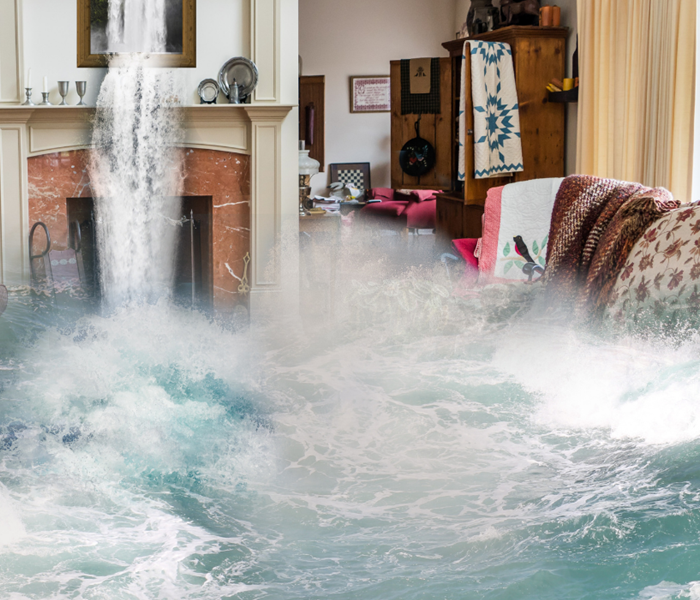 Standing water can lead to structural damage and mold. If you've experienced a burst pipe or a flood, call us at 212-768-9400 for immediate help!
Standing water can lead to structural damage and mold. If you've experienced a burst pipe or a flood, call us at 212-768-9400 for immediate help!
Surface water can affect your Midtown Manhattan home and its tenants in multiple ways. While this standing water can absorb into materials and ultimately allow for the deterioration of exposed structural elements, pooling can also present potential health effects or hazards for those exposed and remaining in the area.
SERVPRO offers fast extraction and drying solutions for your Midtown Manhattan home after a flood.
We can help reduce the standing water concerns by offering efficient flood removal for Manhattan homes. To accomplish this, we can call upon a wide array of extraction and moisture removal tools in our broad inventory.
What Tools Are Best for Drying Up Flood Damage?
Because every flooding situation is different from the last, there are different tools and devices that are best to remove water or dry the area. Identifying the most efficient solution is always the priority, as the sooner standing water gets addressed, the less damaging flooding typically becomes. Some of the standard water removal and drying tools include:
- Air Movers
- Dehumidifiers
- Positive Pressure Systems
- Floor Mat Systems
After a flood, you want your home to look like it did before the disaster as soon as possible. Our SERVPRO of Midtown Manhattan team can help anytime you need us. Call us today at (212) 768-9400
How to Prepare for a Storm
4/13/2021 (Permalink)
Storms can be as unexpected as the damage they cause. Often, with the right preparation, much of the storm damage can be minimized or prevented altogether. Here are some tips to help prevent the damages storms may cause.
Clean Your Gutters
When it rains, and your gutters are clogged, it could cause the overflow to run down into your home. Often, this water can go undetected and sit. Over time, mold can grow in these areas that remain wet. Having clean and sturdy gutters before the rain comes can minimize the damage a storm may cause.
Landscaping and drainage
Depending on the land your home is built, water runoff can accumulate around your foundation, and flood your homes. Fortunately, there are solutions with the right landscaping. Better pathways can be created for water runoff, guiding the water away from your home. If you have noticed puddles or water accumulation near your home when it rains, contact a professional to help, before a storm comes. That can make the difference in whether your home is damaged or not.
Damaged or Dead Trees
Storm damage often occurs when a tree or limbs break off and falls onto a home. Snow and rain can weigh down trees, while wind can make them bend. If this happens to trees and limbs that are dead or damaged, there’s a high chance that they will break. Before the storm season comes, be sure to trim your trees, and remove all dead limbs.
Spring Checkup: How to Inspect Your Property for Winter Damage
4/12/2021 (Permalink)
With a long winter behind us, New Yorkers can look forward to blooming flowers and spring cleaning. To make sure your home is in good shape, here are some tips to inspect for damage to save you money in the long term from property damage.
Even after a mild winter, it is critical to assess your property’s exterior to make sure the cold weather hasn’t left you with water damage. It is also important to react quickly and take the necessary steps to prevent property damage from compounding effect of rain showers to come this spring.
Winter weather can be hard on your residential and commercial property be sure to look for problems that frigid temperatures, snow and ice may have caused.
Winter storms are accompanied by lots of moisture – snow, freezing rain, ice, hail and wind. This can create common issues like ice dams, frozen pipes and frost heave that may cause damage to your home or business. SERVPRO of Midtown Manhattan is always here to help resolve your property damage restoration needs quickly.
Our local disaster restoration services includes:
- Inspection and Assessment of any damaged areas
- Water Removal
- Water Extraction
- Drying and Dehumidification
- Cleaning and Repairs
- Restoration and Reconstruction, as necessary.
There are several common problem areas to inspect during spring for potential damage, including your roof and gutter system, foundation and yard, plumbing system and your property’s exterior. From the top down these areas could see potential damage from the worst that the winter elements can bring.
From your roof to your plumbing, here are some signs of damage to look out for:
Roof and Gutter System Damage
The function of your roof and gutter system is to remove excess water from your property to prevent damage. High winds, hail and winter storms can tear off or destroy shingles and ice can obstruct the flow of water in gutters and downspouts, allowing water to breach the structure. Winter forces can cause obvious holes in your roof from wind or branches, but additionally less noticeable damage from hail or other debris can cause indentations and divots that overtime can lead to ice and moisture damage. Heavy buildup of ice on your roof can cause your gutters and downspouts to separate from your roofline, disrupting the flow of water and cause water intrusion and damage to the inside of your home or business.
Window, Door and Exterior Damage
Cold temperatures, snow and hail can take a toll on the structure of your property including the windows, doors and exterior of your home or business. Without proper repair, peeling paint, cracks in sealant and other damage could lead to moisture infiltration and a water damage disaster. After winter passes, damaged paint should be removed, primed, sealed and repainted. Cracks and air leaks should be sealed and repaired to prevent more devastating damage later, and missing siding should be replaced before springtime showers arrive to prevent additional water and structural damages.
Foundation and Other Drainage Problems
Another potential casualty of winter weather is your foundation and yard. Hairline cracks in the concrete of a foundation that develop naturally over time can expand, causing major structural damage over time if not properly taken care of quickly. Water can find its way into cracks, freeze and make them larger during the frigid cold months of winter. Getting your foundation repaired in the spring can help prevent more problems from developing as time goes by. The best way to avoid foundation damage is to keep moisture moving away from your foundation. Each spring check your gutters and downspouts for debris or clogs, make sure they are functioning properly, and that they drain at least 10 feet away from your home. Make sure the ground around your home is graded away from your foundation and consider adding a rain garden to your property to combat a bigger problem.
Plumbing Damage
Another vulnerable system in your home or business that could be damaged from cold winter temperatures is your plumbing. To adequately deliver water to and from your sinks, boiler, and your plumbing system keeps the water forever flowing. However, during cold winter days and nights cracks and stresses can occur and eventually lead to leaks and pipe breaks that can have a damaging effect on your local commercial or residential property. Remember to survey your pipes regularly for cracks and leaks, paying closest attention to the pipes that are closest to the elements or in poorly insulated areas such as the basement or crawlspace, or outside walls and attics. Take this opportunity to add some additional insulation as a precautionary measure for the future winter weather to come.
Preventing Property Damage Starts With Routine Inspection
Taking a proactive approach to property damage starts with inspecting your property for damage. First and Secondary water damage is multi-faceted and can affect almost every area of your home or business which had water or flood intrusion. If you see any signs of suspected water damage or other types of property damage including mold, smoke, biohazard, your best course of action is to contact SERVPRO of Midtown Manhattan. We are trained and certified to handle your water restoration, mold remediation, and other cleanup and property restoration needs. We can arrive quickly perform an inspection, and get you started on the road to recovery and restoration, “Like it never even happened.”
Need help with Storm Damage? Give us a call at (212) 768-9400!
Thunder Storms: How to Prepare
4/12/2021 (Permalink)
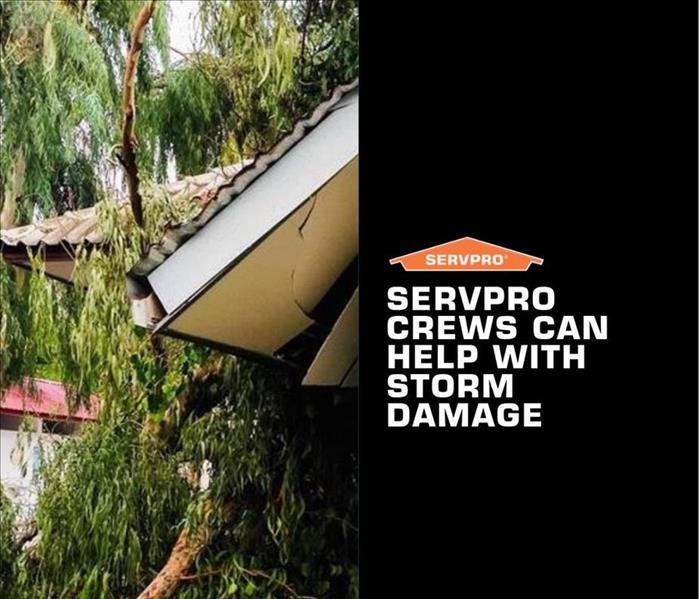 We're Here to Help with any Storm Damage You Might Be Facing.
We're Here to Help with any Storm Damage You Might Be Facing.
Thunderstorms have the potential to be very dangerous. Make sure you follow these tips to prepare you and your household for a potentially dangerous storm. Thunderstorms happen often and can cause a lot of damage to your home. Of course, there are ways to help prevent or minimize any damage. To prepare for a Thunderstorm, you should do the following:
- Build an emergency kit and make a family communication plan.
- Remove dead or rotting trees and branches that could fall and cause injury or damage.
- Secure outdoor objects that could blow away or cause damage.
- Stay inside your home or a secure building.
- Shutter windows and secure outside doors. If shutters are not available, close window blinds, shades or curtains.
Some Thunderstorm Trivia You May Not Know:
- Thunderstorms can occur in clusters or in a line formation.
- A single thunderstorm can be very severe if the storm stays in place, pummeling a location for a prolonged time.
- Warm, humid conditions are highly favorable for development of Thunderstorms.
Dealing with Storm Damage? Call our team at SERVPRO of Midtown Manhattan for help!
Call us today - 212-768-9400
Preparing for Winter Weather
1/22/2021 (Permalink)
 Stay prepared with these winter safety tips!
Stay prepared with these winter safety tips!
When you are dealing with storm, flood, and water damage, immediate action is crucial. You should choose the company with storm damage experience and expertise that has the resources and equipment to handle the job. SERVPRO of Midtown Manhattan can respond immediately to storm and flooding conditions. Here are some helpful tips that better prepare your home and business during these harsh winter months. And remember to add our phone number to your contact list as your choice for emergency fire and water damage cleanup; 212-768-9400.
Staying Prepared Tips
- Keep cabinet doors open during cold spells. This allows warm air to circulate around pipes.
- Keep a slow trickle of water flowing through faucets, especially if the pips for faucets run through unheated or uninsulated areas of your home.
- Consider shutting off outdoor faucets. Find the shut-off valve in the basement or crawl space and turn it off.
- If you follow the previous step, then open the outdoor faucet to help ensure it drains completely and the inner valve is shut off.
- Ensure gutters are clean and secure. Leaves and debris accumulate, causing a damming effect on gutters, which could lead to roof problems and water damage.
- Proper maintenance of your furnace can help reduce the risk of puffbacks.
PREPARE YOUR BUSINESS:
- Check your business property for downed tree limbs and branches. Weather, such as wind, heavy rain, ice and snow can cause branches to fall, which could cause damage to the property and potentially cause personal injuries.
- Inspect walkways, and parking lots, for proper drainage to alleviate flood hazard potentials.
- Inspect all handrails, stairwells and entryways to address and correct potential slippery or hazardous areas.
- Install mats or non-slip surfaces and post caution signs where water could be present.
- Ask SERVPRO of Midtown Manhattan about starting a Disaster Recovery Plan for your business.
How To Be Prepared for a Hurricane
5/29/2020 (Permalink)
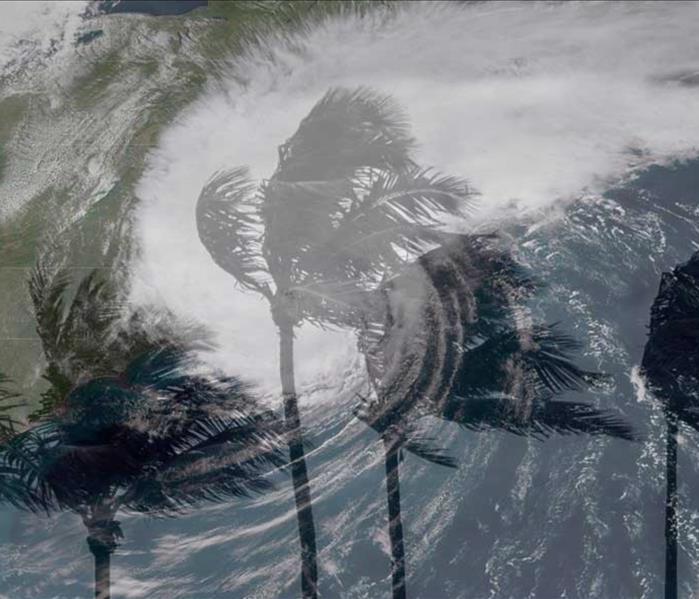 Are you ready for hurricane season?
Are you ready for hurricane season?
FEMA Hurricane safety tips: Learn what to do before a hurricane.
To prepare for a hurricane, you should take the following measures:
- For beginners, you should have an emergency response protocol in place. SERVPRO of Midtown Manhattan can assist you with this by creating a complimentary Emergency Ready Profile customized to your property. Your ERP can help you with building a plan in the event of an emergency. Additionally, you should have a first aid kit with all essentials and a communication plan in place for the security of you and your family.
- Know your surroundings.
- Learning the elevation level of your property will help you know how your property will be affected when tidal flooding or storm surges are forecasted.
- Identify and determine whether levees and dams in your area pose a hazard to you.
- Learn community hurricane evacuation routes, how to find higher ground, and determine where you would go and how you would get there if you needed to evacuate.
How to Make a Plan for Securing my Property?
- Cover all windows. Permanent storm shutters offer the best protection for windows. Another option is to board up windows with 5/8” marine plywood, cut to fit and ready for install. Tape will not prevent windows from breaking.
- To reduce roof damage, install straps or additional clips to securely fasten your roof to the frame structure.
- Ensure trees and shrubs around your home are well trimmed so they are more wind resistant.
- Clearing loose and clogged rain gutters and downspouts will reduce soil erosion which can affect your homes foundation and cause water damage.
- Reinforce your garage doors to avoid dangerous and expensive structural damage.
- Plan to bring in all outdoor items that may not be tied down: furniture, decorations, garbage cans and anything else.
- Secure your boat if you own one.
- Install a generator.
- Be prepared to take shelter on or below the 10th floor if you’re in a high-rise building.
- Consider building a safe room.
SERVPRO is the leading restoration company in the industry. SERVPRO of Midtown Manhattan knows the key to limiting business interruption is fast mitigation. SERVPRO of Midtown Manhattan is equipped to remediate disasters of any size and will be onsite within a couple of hours helping reduce future damage, with the right equipment, training and procedures to ensure your structure is back to a state "Like it never even happened," while saving you time and money.
April Showers Brings May Flowers
4/20/2020 (Permalink)
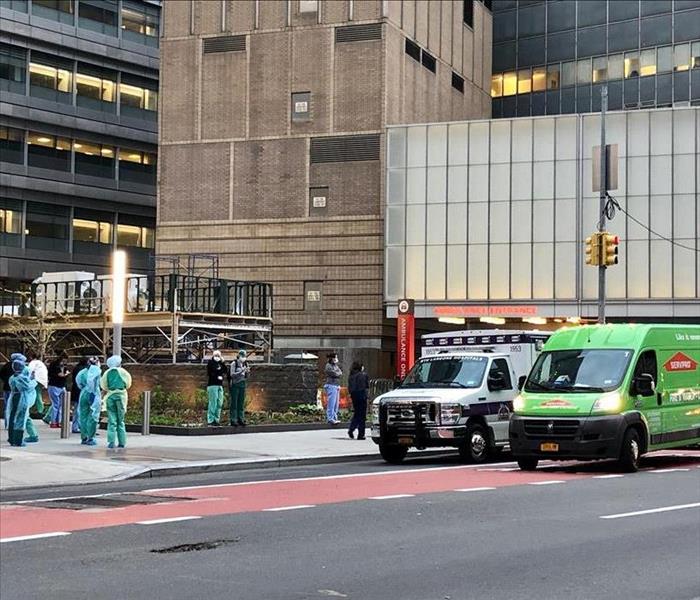 We are continually on the frontlines fighting alongside essential workers and healthcare professionals.
We are continually on the frontlines fighting alongside essential workers and healthcare professionals.
We all know the saying ‘April Showers bring May Flowers’, and right now we are in one of the largest storms we’ve faced. Navigating COVID-19 has been a tumultuous task. SERVPRO of Midtown Manhattan is continually on the frontlines of this fight working alongside essential workers and healthcare professionals. We are here to help those in need and who have been affected by the coronavirus. How are we helping clean our community?
- We use Eco-Friendly products: SERVPRO is an eco-conscious brand. All of our products are safe to be used in homes or office spaces. We have more about our products in our blog ‘Protect Your Home’
- We follow CDC guidelines: We send our employees into the field fully protected in full PPE. We take our employees' health seriously and aim to protect them everyday.
- Offering Proactive Cleaning: Before COVID-19 took hold of New York City, our team was prepared for the fight by offering proactive cleaning to a multitude of offices, retailers, and essential businesses.
- Cleaning from Top to Bottom: We offer fogging services that clean up to 8ft up all the way to your floor. We are helping slow the spread of COVID-19 through continuous cleanings throughout the city.
- Preparing for Openings: We are ensuring the safety of your space before opening back up to the public. Our team is staying aware of when openings are as dates continue to shift.
- Acts of Service: We are putting our essential workers first by providing weekly lunches for the military that has come in to support New York City.
We are incredibly ready to help get things back to a new normal. We want to help get New York moving and ready for business. As a business that plays a vital role in commercial clean-up, we will be there when you need us. We are all in this for the long haul and New York City has been doing an amazing job showing the world why we are the best city. We have worked together through a multitude of storms and we only come out of it stronger and more united. Call us today at (212)768-9400 to see how we can help you prepare for re-opening your doors. We can service you within Manhattan and beyond.
When the Lights Go Out
4/13/2020 (Permalink)
 2003 Northeast Blackout
2003 Northeast Blackout
Power Outages, they happen to everyone. We want to make sure you are prepared for whatever may come your way during one. With summer around the corner and the potential of air conditioners blasting to cool down your apartment, power outages do happen. In the city a power outage can be pretty nerve-wracking, but we want to be there to help you feel safe. So what do you do in the unfortunate event of a power outage?
Think battery operated! From battery operated lanterns and flashlights to phone chargers, having extra batteries on hand and making sure your devices are able to be charged is crucial.The NYC Emergency Information App has been a lifesaver for me. It gives you not only information on emergency events, but also on planned events throughout the city. Having charged devices will allow you to stay in contact with news, family, and friends.
Candles! Who doesn’t collect candles in New York City? Usually we just use them to make a space feel more cozy, but in a blackout you may be using them as a source of light. Be sure to keep them away from curtains or in spaces where they could be easily knocked over.
Food! Most New Yorkers may not be fans of cooking, but having a few staples in your pantry may be just what you need during a power outage. When takeout is not an option we may have to resort to canned soups or cereals. Hopefully your apartment has a gas stovetop! That will still be of use during an outage other than just being a home for pots and pans you don’t have storage for.
Staying in place during a power outage is ideal, but not always an option. If you are caught on the streets during a power outage we suggest making your way home. Keep an eye on New York City’s major transit sites to ensure the train you need is running. Hailing a cab or grabbing a shared ride can be difficult during this time. If walking is too far, there are also Citi bikes!
While we may not enjoy a power outage sometimes it is nice to be able to open your window and wait for the storm to pass. We hope you stay safe and remember to minimize the amount of electricity you use during a heatwave!
Here are some more useful contacts during a blackout:
- For power and electricity outages, call the Con Edison 24-hour hotline: 1-800-75-CONED (752-6633) (TTY: 800-642-2308). You can also report an outage online on Con Edison’s website.
- For heat and gas outages, call National Grid 24-hour hotline: 718-643-4050 (TTY: 718-237-2857)
- If you live in New Jersey, call PSEG 24-hour hotline: 1-800-436-7734 (TTY: 631-755-6660)
Here To Help
4/8/2020 (Permalink)
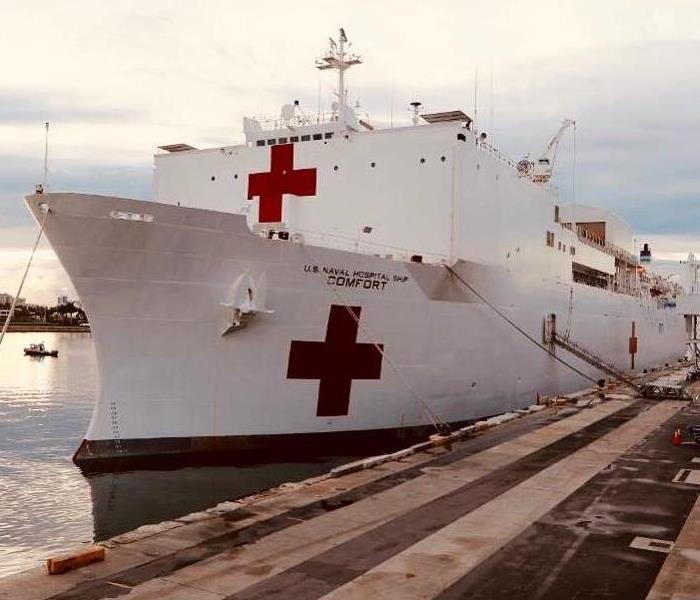 The U.S. Navy hospital ship USNS Comfort
The U.S. Navy hospital ship USNS Comfort
During this time we are seeing our Emergency Response Teams at the forefront ensuring the health and safety of our country’s citizens. Hospital staff are putting their lives and the lives of their families at risk in order to treat the many flooding NY hospitals. Police are patrolling neighborhoods ensuring people are not congregating, and we are abiding by lockdown rules. Restoration companies and custodial workers are putting in the elbow grease in cleaning and sanitizing facilities for when facilities and businesses return to normal.
What can we do to help?
Stay home. Wash your hands and avoid touching your face. Wear gloves and a mask outdoors to limit the spread.
People are under a lot of stress at this time. Many of us are working from home. Schools are out and students are being homeschooled. Confirmed cases are continuing to rise, and people are becoming stir-crazy. Practicing self care is important in maintaining mental stability. Turn off the televisions, have some quiet time, exercise, take a relaxing bath, listen to music or work on a hobby.
If you are exhibiting mild symptoms and have no underlying pre-existing conditions, stay home and isolate yourself from others to avoid potential spread.
In this time, it is essential for us to come together as a community by keeping our distance in order to alleviate the demand on hospital resources and allow the most vulnerable cases to be treated effectively. It is important we keep stress levels to a minimum and show compassion to those suffering economic loss at this time. Give if you are able to give. Lend a hand if you’re able. Honor those who care enough to devote their lives for the benefit of our community.
Keeping Your Pet Safe During a Storm
4/8/2020 (Permalink)
 Our owner Robert's puppy friend, Baxter
Our owner Robert's puppy friend, Baxter
When a thunderstorm or hurricane is upon us, it is key to have precautions in place. In our previous blog, In High-Waters, we discussed the importance of having a plan of action. What about a plan for those who cannot care for themselves?
Your pets are your family, and we know the importance they hold. Preparing for a storm can be overwhelming to think about, but it will make everything run smoother in the long run. We have created some steps to protect your little furry friends.
Keep your pets inside if possible: This is the best way to guarantee that they will not run away while scared.
Not only do you need to have supplies for yourself, you need to have supplies for your furry friend.
Here are some of the supplies you may need:
Water for each pet
Non-perishable pet food
Pet medications
Leashes and ID Tags
Dog Bed, Toys, and Treats
First Aid Kit
Vaccinations are up to Date
So you did everything you could, but somehow your pet still escapes.
What to do if your pet escapes:
Stay Calm: This is easier said than done. You need to protect yourself and your pet. Many pets get nervous due to storms and hearing their owner yell may make them think they are in trouble.
Microchip your pets: If your pet does escape from your backyard, it is imperative there is a way for an animal shelter or vet to reach you and verify that you are the owner of your pet.
Current Pictures of your Pets: This will make it easier to locate your pet via social media or flyers.
Pet ID: Making sure your pets tags are up to date is imperative. Always include a phone number and Owner’s name.
Prepare for Possible Injuries:Is it serious or something you can take care of yourself? Call a vet, they may be able to help you over the phone.
Keeping your best friends safe is always a priority. Make sure you are prepared to care for those who look to you for safety everyday.
What to Do With a Broken Window
8/6/2019 (Permalink)
Storms can lead to unexpected damages in your home that can cause much bigger issues. In the event of a broken window, it is important deal with this issue immediately.
First you must take photos of the damage for insurance purpose and then clean the glass from the area as best as possible to minimize risk of cutting yourself. Once the glass is cleaned, a tarp can be secured over the window until a new window can be put in.
A restoration company like SERVPRO can be used to do the full clean up and assess anymore damages after a storm. Never hesitate to contact the professionals.
Tornado Safety Tips
6/14/2019 (Permalink)
With the extreme shifts in weather patterns, it is more important now than ever to be prepared for whatever.
Here are some suggestions on safety during a tornado from FEMA:
If you are at home during a tornado:
- Go to a windowless interior room on lowest level of your house. Go to a storm cellar or basement if your house has one. If there is no basement, go to an inner hallway or a smaller inner room without windows, such as a bathroom or closet.
- Get away from the windows.
- Go to the center of the room. Stay away from corners because they tend to attract debris.
- Get under a piece of sturdy furniture such as a workbench or heavy table or desk and hold on to it.
- Use your arms to protect head and neck.
- If you are in a mobile home, get out and find shelter elsewhere.
If you are at work or school during a tornado:
- Go to the basement or to an inside hallway at the lowest level.
- Avoid places with wide-span roofs such as auditoriums, cafeterias, large hallways, or shopping malls.
- Get under a piece of sturdy furniture such as a workbench or heavy table or desk and hold on to it.
- Use your arms to protect head and neck.
If you are outdoors during a tornado:
- If possible, get inside a building.
- If shelter is not available or there is no time to get indoors, lie in a ditch or low-lying area or crouch near a strong building. Look out for flood waters which may also fill low areas.
- Use your arms to protect head and neck.
If you are in a car during a tornado:
- Never try to drive faster than a tornado in a car or truck. Tornadoes can change direction quickly and can lift up a car or truck and toss it through the air.
- Get out of the car immediately and take shelter in a nearby building.
- If there is no time to get indoors, get out of the car and lie in a ditch or low-lying area away from the vehicle. Be aware of the potential for flooding.
The More You Know...
6/10/2019 (Permalink)
Knowledge is invaluable when disaster strikes. Having a plan in place can keep us safe.
Here our some tips from the American Red Cross concerning Thunderstorms:
About Thunderstorms
A thunderstorm is considered severe if it produces hail at least 1 inch in diameter or has wind gusts of at least 58 miles per hour. Every thunderstorm produces lightning, which kills more people each year than tornadoes or hurricanes. Heavy rain from thunderstorms can cause flash flooding, and high winds can damage homes and blow down trees and utility poles, causing widespread power outages.
Know the Difference
Severe Thunderstorm Watch - Severe thunderstorms are possible in and near the watch area. Stay informed and be ready to act if a severe thunderstorm warning is issued.
Severe Thunderstorm Warning - Severe weather has been reported by spotters or indicated by radar. Warnings indicate imminent danger to life and property.
Every year people are killed or seriously injured by severe thunderstorms despite advance warning. While some did not hear the warning, others heard the warning and did not pay attention to it. The information in this section, combined with timely watches and warnings about severe weather, may help save lives.
6 Tips for Pet Safety During a Hurricane
4/5/2019 (Permalink)
Hurricanes are frightening for us and can have the same effect on our furry friends. Having a plan in place can keep you and your pets calm during the storm. Here are some pet friendly tips from Pet MED:
1. Make a Plan
Have supplies set aside and ready. This includes: an emergency kit, pet supplies in a separate bag ready to go, and an escape option.
2. Be a Stickler
Whatever your decision is, stick to it. Otherwise, you may put your pet in real danger. If you decide to leave town at the first sign of warning, then do so as planned. Changing your mind or changing the plan often leads to unnecessary confusion.
3. Get Your Kit On
A pet emergency kit isn’t that much different to yours. Enough water for three days, non-perishable food (include a can opener if needed), a solid carrier, litter, litter box, puppy pads, plastic bags, medicine and medical records for both you and your pet in waterproof containers, extra leash, and a picture of your pet on you in case the worst happens and you get separated. Tags and/or microchipping your pet will also make it easier to recover, should it get lost.
4. Staying In
If you’re staying home to ride out the storm, keep your pet in its carrier or on a leash. You never know when you might be forced to evacuate. And even if that doesn’t happen, you don’t want to be tracking down a petrified pet during the chaos. Therefore, secure your pet before the storm hits.
5. Going Out
Stay tuned to the news reports. If you’re told to evacuate, you must do so at first warning. Moreover, it helps to have everything ready to go. We suggest a backpack that holds all the essentials for you and your pet. And make sure you know ahead of time exactly where all the shelters are and how to get there.
6. Stay Calm
Whether you leave early, choose to stay, or are required to evacuate due to the storm's severity or due to house damage, remember to stay calm. Your pet can sense your emotions, so a calming demeanor can lead to a less-panicked pet. Oh, and don't forget to speak to your pet in a calm, soothing voice, too.
Hurricane Evacuation Tips from NYC GOV
4/5/2019 (Permalink)
New York residents are not strangers to the extraordinary, but being prepared is always in fashion. Check out these evacuation tips from NYC.gov, being in the know is en vogue!
If You Must Evacuate
- Know your zone. Determine whether you live in an evacuation zone by using the Hurricane Evacuation Zone Finder at NYC.gov/knowyourzone or call 311 (212-639-9675 for Video Relay Service, or TTY: 212-504-4115). Zones are color-coded and labeled 1, 2, 3, 4, 5, and 6 when represented on a map. If your address is in one of the City’s hurricane evacuation zones, you may be ordered to evacuate if a hurricane threatens New York City.
- Evacuees should be prepared to stay with friends or family who live outside evacuation zone boundaries.
- If you cannot stay with friends or family, use the Hurricane Evacuation Zone Finder, or call 311 (212-639-9675 for Video Relay Service, or TTY: 212-504-4115) to identify which evacuation center is most appropriate for you.
- Evacuation information is subject to change. For the latest information, visit NYC.gov or call 311 (212-639-9675 for Video Relay Service, or TTY: 212-504-4115). Visit the MTA's website at www.mta.info or call 511 for the latest transit information. If you need assistance evacuating during an emergency, please call 311.
- Information on evacuation centers, including accessibility features, is subject to change. Please visit NYC.gov/knowyourzone or contact 311 for updated reports on building status and accessibility features.
- When a coastal storm is approaching, the City may order the evacuation of neighborhoods in danger of flooding from storm surge, starting with zone 1 and adding more zones as needed. Zones will be evacuated depending on life safety-related threats from a hurricane’s forecasted strength, track, and storm surge.
*If the City issues an evacuation order for your area, do so as directed.* The City will communicate through local media specific instructions about which areas of the city should evacuate. If a mandatory evacuation is issued, do so as directed. Use public transportation if possible, keeping in mind that public transportation may shut down hours before the storm. For additional information about how to evacuate, including transportation options, please contact 311 (212-639-9675 for Video Relay Service, or TTY: 212-504-4115).
How to Evacuate
Since flooding and high winds can occur many hours before a hurricane makes landfall, evacuees should leave their homes immediately if instructed to do so by emergency officials. The City strongly recommends evacuees stay with friends or family who live outside evacuation zones. Evacuees should plan their mode of transportation with special care and take the following steps:
- Plan to use mass transit as much as possible, as it offers the fastest way to reach your destination. Using mass transit reduces the volume of evacuees on the roadways, reducing the risk of dangerous and time-consuming traffic delays. Please note that public transportation may shut down hours before the storm.
- Listen carefully to local news media, which will broadcast reports about weather and transportation conditions.
- Leave early. Hazards like strong winds, heavy rain, and flooding may force the early closure of roads, bridges, and tunnels. Also, evacuate early if you rely on elevators to get out of your building. Elevators may be out of service and may not be available at all times.
- Allow additional travel time and consider your transportation, dietary, and medical needs (oxygen, extra batteries/chargers, eyeglasses, prescriptions, etc.). Bring all medications with you and have contact information for your health providers written down to carry with you.
- The City advises against car travel during an evacuation. The City will be working hard to keep roads clear, but traffic is unavoidable in any evacuation.
- Be ready for a long, slow trip. The City will monitor conditions along major transportation routes to help vehicular traffic flow as smoothly as possible.
- Evacuation route signs point the way to high ground, away from coastal flooding. If you must evacuate, leave your home before storm conditions make roadways unsafe.
- Stay tuned to local media for information about road and bridge closures. New York State's 511 can help you monitor traffic on State roads.
- Many evacuation centers do NOT have parking available.
- Wind restrictions and vehicle bans may be implemented on area bridges. Large vehicles such as trailers, trucks, other vehicles with higher wind profiles will be restricted sooner than cars or SUVs.
- In any significant rainstorm, *avoid driving through standing water.*
Tips for Hurricane Preparedness
3/26/2019 (Permalink)
As the leader in water damage restoration, SERVPRO of Midtown Manhattan knows fast mitigation is the key to limiting business interruption. SERVPRO of Midtown Manhattan is faster to any size disaster and can be on-site within a few hours to help reduce the future damage water can cause. We have the right equipment, procedures and training to help ensure the structure is dry the first time, saving you time and money.
FEMA Hurricane safety tips: Learn what to do before a hurricane.






 24/7 Emergency Service
24/7 Emergency Service

